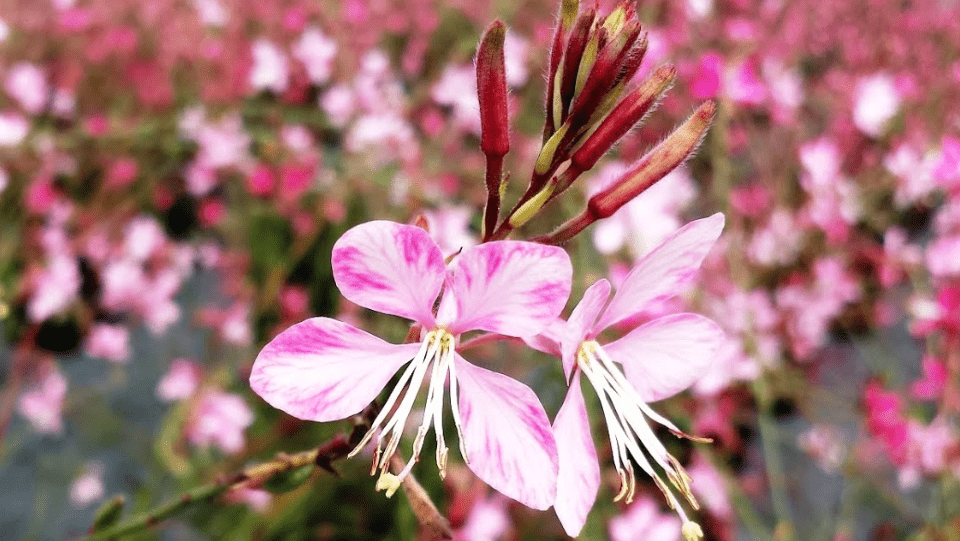
Flower Gaura: Transform Your Garden with These Graceful Flowers
Are you looking to add a touch of grace and beauty to your garden? Look no further than the stunning flower Gaura. In this post, we will explore the unique qualities of Gaura plants and provide tips on how to care for them in your garden. Whether you’re a seasoned gardener or just starting out, incorporating Gaura into your garden design will bring a sense of elegance and charm to your outdoor space. So, let’s dive in and discover how you can transform your garden with these graceful flowers.
Table of Contents
ToggleUnderstanding Flower Gaura
1.What is Flower Gaura?
Flower Gaura, also known as wandflower or bee blossom, is a delicate and graceful plant that produces beautiful, dainty flowers on long, wiry stems. The flowers come in a variety of colors, including white, pink, and bi-colors, adding a pop of color to any garden. Gaura is a native plant to North America and is known for its ability to attract pollinators such as butterflies and bees. Its airy, ethereal appearance makes it a standout addition to any garden.
A.Botanical name and family
The botanical name for Flower Gaura is Gaura lindheimeri, and it belongs to the Onagraceae family. This perennial plant is native to North America and is known for its delicate appearance and long blooming period.
B.Description of the plant (appearance, size, flower color, etc.)
Flower Gaura is a perennial plant that grows in a clump formation, reaching a height of 2 to 4 feet. It has long, slender stems with small, dainty flowers in colors such as white, pink, and bi-colors. The flowers have a delicate, ethereal appearance and create a graceful, airy effect in the garden. The plant has a wispy, almost grass-like appearance, with long, narrow leaves. It is a low-maintenance plant that is easy to grow and adds a touch of elegance to any garden.
2. Origin and Habitat
Flower Gaura is native to North America, specifically the southern United States and northern Mexico. It grows in open, sunny areas and is often found in prairies, meadows, and along roadsides. It prefers well-drained soil and can tolerate dry conditions, making it a hardy and adaptable plant. In its natural habitat, it provides food and habitat for butterflies and other pollinators, adding to its ecological value.
Varieties of Gaura
1.Popular Varieties:
A.Gaura lindheimeri
Gaura lindheimeri, also known as Flower Gaura, is a low-maintenance plant native to North America. It has a wispy, grass-like appearance with long, narrow leaves and is often found in open, sunny areas such as prairies and meadows. It prefers well-drained soil and can tolerate dry conditions, making it a hardy and adaptable plant.
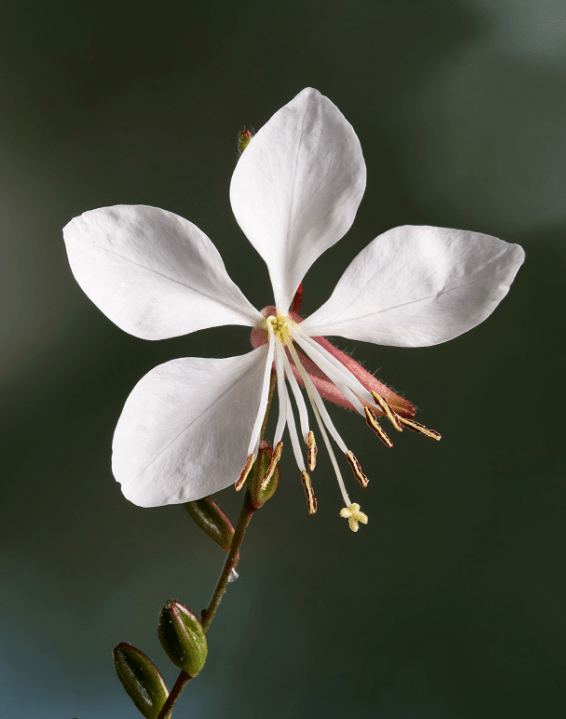
B.Gaura biennis
Gaura biennis, commonly known as biennial gaura, is a plant species native to North America. It is a biennial plant, meaning it completes its life cycle over the course of two years. Gaura biennis produces tall flower spikes with small, star-shaped white or pink flowers that bloom in the summer. It is an attractive plant for pollinators, such as bees and butterflies, and is often used in wildflower gardens and naturalized landscapes. Gaura biennis prefers full sun and well-drained soil, making it a low-maintenance addition to garden spaces.
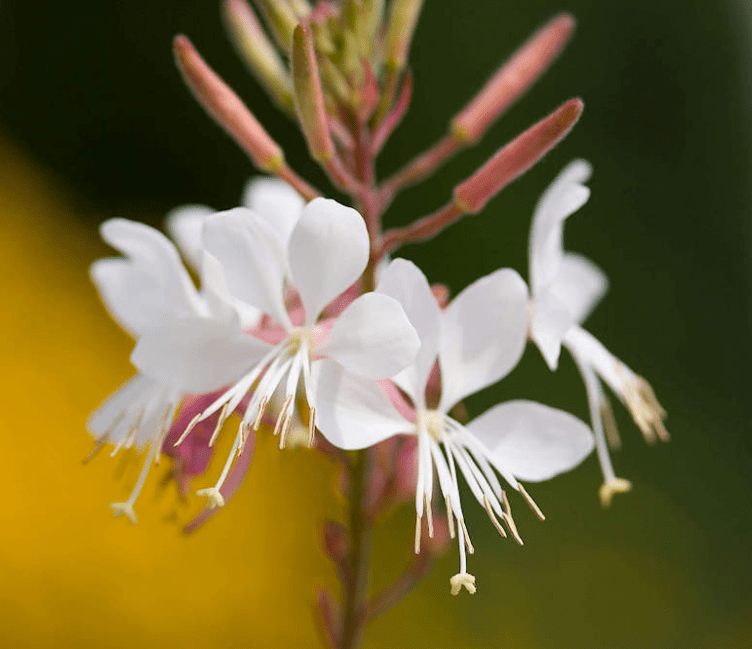
C.Siskiyou Pink
Gaura ‘Siskiyou Pink’ is a beautiful and hardy perennial plant that is native to the Southwestern United States. It is known for its long, arching stems and delicate pink flowers that bloom from late spring to early fall. ‘Siskiyou Pink’ is a favorite among pollinators, attracting butterflies and bees to its nectar-rich blooms. This plant prefers full sun and well-drained soil, making it a great addition to gardens, meadows, and naturalized landscapes.
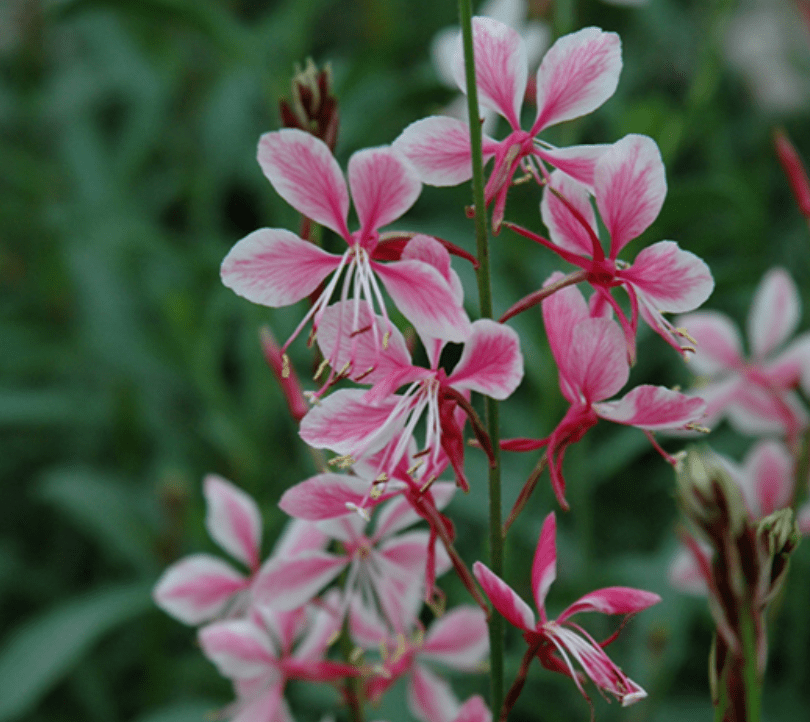
D.Crimson Butterflies
Crimson Butterflies’ is a cultivar of Gaura lindheimeri, commonly known as wandflower. It is a perennial plant with a bushy, compact growth habit and produces tall spikes of deep crimson-pink flowers that resemble butterflies. This variety is known for its long bloom period and is a favorite among gardeners for its low-maintenance nature and attractive flowers. ‘Crimson Butterflies’ prefers full sun and well-drained soil, making it a versatile and adaptable plant for gardens and landscapes.
2.Choosing the Right Variety for Your Garden
When selecting a Gaura variety for your garden, consider the specific characteristics and needs of each variety. Gaura biennis is great for attracting pollinators and thrives in full sun and well-drained soil, making it a low-2.Soil Preparationmaintenance option for wildflower gardens. ‘Siskiyou Pink’ is a native perennial with delicate pink flowers that also attracts pollinators and prefers similar growing conditions. If you’re looking for a compact variety with deep crimson-pink flowers, ‘Crimson Butterflies’ is a great option for gardens and landscapes. Consider the specific qualities you’re looking for in a Gaura plant, and choose the variety that best suits your garden’s needs.
Planting Flower Gaura
1.When to Plant
Plant Gaura in the spring after the last frost has passed, or in the fall before the first frost. This will give the plant time to establish itself before the extreme temperatures of summer or winter. Make sure to plant in an area with full sun and well-drained soil for the best results.
2.Soil Preparation
Prepare the soil by loosening it to a depth of 12-18 inches and incorporating organic matter such as compost or peat moss to improve drainage and fertility. Gauras prefer slightly acidic to neutral pH levels, so adjust the soil if necessary. It’s important to ensure that the soil drains well, as Gauras do not tolerate wet or waterlogged conditions.
3.Planting
Dig a hole that is twice as wide and just as deep as the plant’s root ball. Gently remove the plant from its container and place it in the hole, making sure the top of the root ball is level with the surrounding soil. Backfill with soil and water thoroughly to settle the plant in place.
Caring for Flower Gaura
1.Watering Needs
Water Gauras regularly, especially during the first growing season, to help the plant establish a strong root system. Once established, they are drought-tolerant and only need to be watered during periods of prolonged dryness.
2.Fertilizing
Fertilize Gauras in the spring with a balanced, slow-release fertilizer to promote healthy growth and abundant blooms. Avoid over-fertilizing, as this can lead to leggy growth and fewer flowers.
3.Pruning and Deadheading
Prune Gauras in early spring to remove any dead or damaged branches and to encourage new growth. Deadheading, or removing spent flowers, will also help the plant produce more blooms throughout the growing season. Simply pinch off the faded flowers to encourage new buds to form. With proper care and maintenance, Gauras can thrive and produce beautiful, delicate blooms in your garden.
Common Problems and Solutions
1.Pests and Diseases
Gauras are generally resistant to pests and diseases, but they may occasionally encounter issues with aphids and spider mites. These can be treated with insecticidal soap or neem oil, applied according to the product’s instructions. Keeping the plant healthy and well-watered can also help prevent pest infestations.
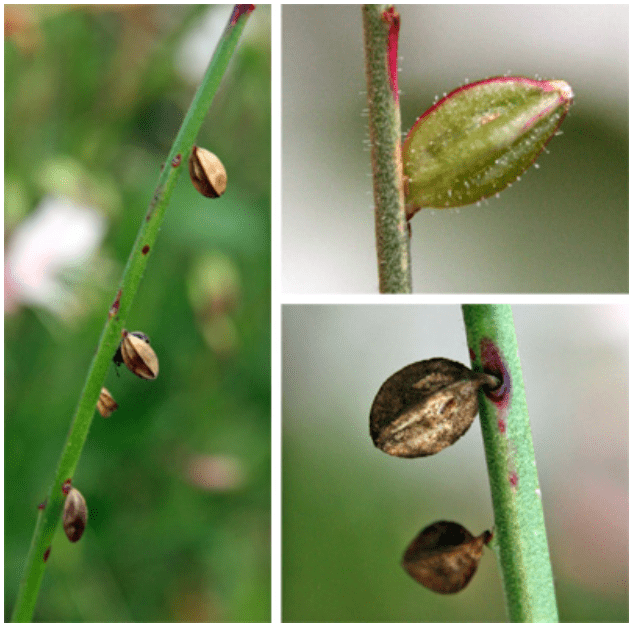
2.Environmental Issues
Gauras can be susceptible to environmental issues such as wind damage and soil compaction. To prevent wind damage, consider staking the plants or providing some form of wind protection. Soil compaction can be addressed by loosening the soil around the plant’s root zone and adding organic matter to improve soil structure. Additionally, be mindful of extreme weather conditions such as frost, as Gauras are sensitive to cold temperatures. Providing proper care and addressing environmental issues can help ensure the health and vitality of your Gauras.
Benefits of Growing Gaura
1.Aesthetic Appeal
Gauras are known for their delicate and elegant appearance, with their long, wispy flower stems and delicate blooms. They add a touch of grace and beauty to any garden or landscape, making them a popular choice for ornamental gardening. Additionally, their flowers attract pollinators such as butterflies and hummingbirds, adding to the visual appeal and biodiversity of the garden. Overall, growing Gauras can enhance the aesthetic appeal of outdoor spaces and provide a lovely and natural atmosphere.
2. Ecological Benefits
Gauras play a role in supporting local ecosystems by providing food and habitat for a variety of pollinators and beneficial insects. Their flowers are a valuable food source for butterflies, bees, and other pollinators, contributing to the overall health and diversity of the surrounding environment. Additionally, Gauras can help improve soil health by adding organic matter and promoting beneficial microbial activity in the soil. By growing Gauras, gardeners can contribute to the ecological balance and health of their local environment.
Landscaping with Flower Gaura
1.Garden Design Ideas
Gauras can be used in a variety of garden design ideas, adding height, texture, and movement to the landscape. They can be planted in groups or mixed with other perennials and annuals to create a dynamic and visually appealing garden bed. Their long, slender stems and delicate flowers make them a great choice for adding a soft and airy feel to the garden. Gauras also work well as border plants, edging pathways, or as a focal point in a mixed flower bed. Their versatility and ability to thrive in different soil and climate conditions make them a popular choice for landscaping with flowers. Overall, Gauras can enhance the overall design and aesthetic of a garden, adding interest and beauty to outdoor spaces.
2.Container Gardening
Gauras can also be used in container gardening to add height and movement to patio or balcony spaces. Their airy and delicate flowers can bring a soft and romantic touch to container arrangements, and their ability to attract pollinators can make them a great addition to a small urban garden. When choosing a container for Gauras, it’s important to select a well-draining pot and use a high-quality potting mix to ensure they thrive in a limited space. With the right care and maintenance, Gauras can bring beauty and elegance to any container garden, making them a versatile and attractive option for small outdoor spaces.
Seasonal Care Tips
1.Spring and Summer Care
In the spring and summer, Gauras require regular watering to keep the soil consistently moist. It’s important to water them at the base of the plant to avoid wetting the foliage, which can lead to mildew and other diseases. Fertilize Gauras with a balanced fertilizer every 6-8 weeks to promote healthy growth and blooming. Deadheading spent flowers can also encourage continuous blooming throughout the season.
2.Fall and Winter Care
In the fall, Gauras can benefit from a light pruning to tidy up the plant and remove any dead or damaged growth. It’s also important to cut back the stems in the winter to prevent them from becoming woody and encourage new growth in the spring. Mulching around the base of the plant can help protect the roots from freezing temperatures and provide insulation during the winter months. Overall, Gauras are relatively low-maintenance plants, but proper care in each season can ensure they thrive and continue to add beauty to the garden year-round.
Propagation of Gaura
1.Seed Propagation
To propagate Gauras from seeds, collect the seeds from the dried flowers in the fall and store them in a cool, dry place. In the spring, sow the seeds in well-draining soil and keep them moist until they germinate. Once the seedlings have grown a few inches tall, they can be transplanted into the garden or larger pots. Gauras grown from seeds may take a year or two to reach their full size and start flowering.
2.Division Propagation
Gauras can also be propagated by division, typically in the spring or fall. To divide the plant, carefully separate the root ball into smaller sections, making sure each section has a good amount of roots and healthy growth. Replant the divisions in well-prepared soil and water them thoroughly. Division propagation can help rejuvenate older plants and create new plants to spread throughout the garden. With proper care and maintenance, propagated Gauras can establish themselves and continue to thrive in the garden.
In conclusion, Gaura flowers are a beautiful addition to any garden, with their delicate petals and graceful movement in the breeze. To care for Gaura plants, make sure to plant them in well-drained soil and provide them with plenty of sunlight. They are low-maintenance and can add a touch of elegance to any garden design. Consider adding Gaura flowers to your garden for a stunning and graceful look.
Frequently Asked Question
Gaura flowers thrive in full sun and well-drained soil. They are also drought-tolerant and can withstand hot and dry conditions.
Gaura flowers are low-maintenance and only require occasional watering and a light pruning to encourage new growth. They also benefit from a balanced fertilizer in the spring.
Gaura flowers typically bloom from late spring to early fall, producing delicate, butterfly-like flowers that dance in the breeze.
Yes, Gaura flowers are known to attract pollinators such as butterflies and bees, making them a beautiful and beneficial addition to any garden.
Gaura flowers can self-seed and spread, but they are not considered invasive in most areas. It’s important to deadhead the flowers to prevent excessive self-seeding.
Yes, Gaura flowers can be grown in containers as long as they have enough space for their roots to spread and are placed in a sunny spot.
Gaura flowers are generally deer-resistant, making them a good choice for gardens in areas with high deer populations.
Gaura flowers can grow anywhere from 2 to 4 feet tall, creating a graceful and elegant presence in the garden.
